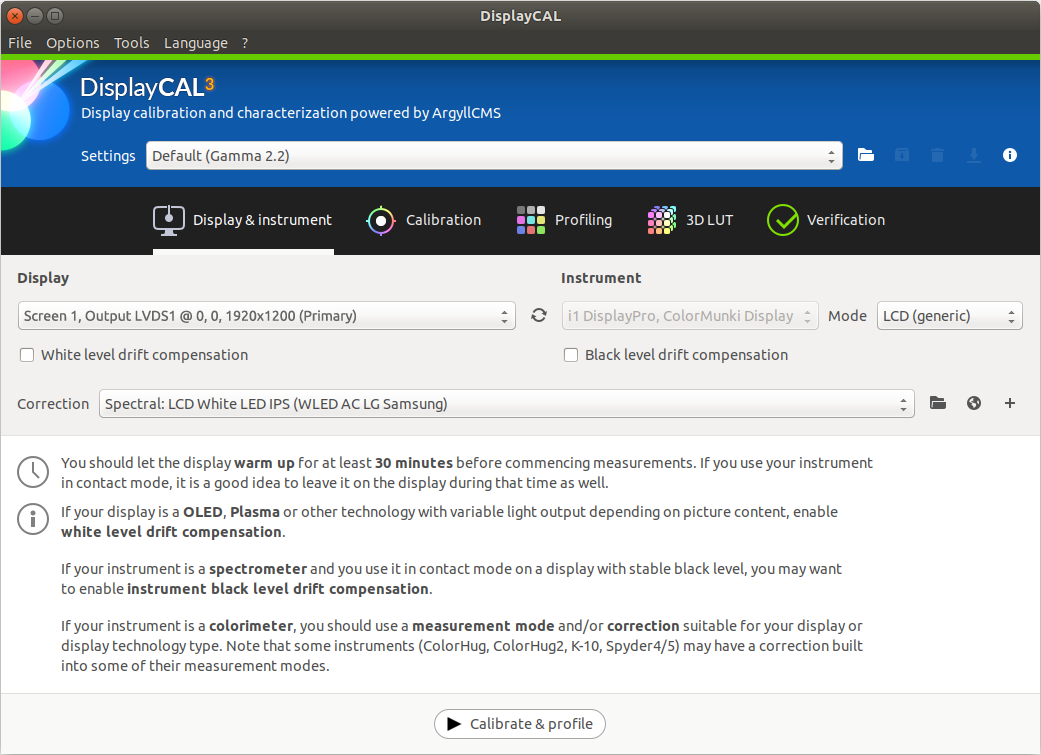 DisplayCAL is een opensourceprogramma gericht op de kleurenkalibratie van een monitor of projector. Het maakt op de achtergrond gebruik van ArgyllCMS en kan met verschillende kalibratieapparaten samenwerken om tot een natuurlijke kleurweergave te komen. Dit wordt voornamelijk toegepast bij zaken waarbij kleurechtheid belangrijk is, denk bijvoorbeeld aan fotografen die foto's op een computer nabewerken of aan het voorbereiden van kleurendrukwerk. De ontwikkelaar heeft DisplayCAL 3.8.8 vrijgegeven met de volgende veranderingen:
DisplayCAL is een opensourceprogramma gericht op de kleurenkalibratie van een monitor of projector. Het maakt op de achtergrond gebruik van ArgyllCMS en kan met verschillende kalibratieapparaten samenwerken om tot een natuurlijke kleurweergave te komen. Dit wordt voornamelijk toegepast bij zaken waarbij kleurechtheid belangrijk is, denk bijvoorbeeld aan fotografen die foto's op een computer nabewerken of aan het voorbereiden van kleurendrukwerk. De ontwikkelaar heeft DisplayCAL 3.8.8 vrijgegeven met de volgende veranderingen:
Changed in this release:Fixed in this release:
- Detect and warn about malformed colorimeter corrections (e.g. from non-official sources). Move them to the trash automatically if they were previously (manually) installed.
- Always enumerate instruments on application startup if more than one instrument was detected the last time the application was used (cross-platform consistency).
- When prompting for instrument calibration, display the just now detected instrument name instead of the previously enumerated name (the latter might be stale if you forgot to refresh after changing connected instruments).
- Use a slightly improved smoothing method when creating high resolution PCS to device tables.
- Increase automatic PCS to device table resolution for L*a*b* LUT profiles to 45x45x45 if using smoothing.
- Only auto-close profile/3D LUT installation dialog after a successful installation.
- Don't auto-close madTPG after 3D LUT installation.
- macOS: Warn if a black luminance calibration target is set.
- Profile loader (Windows): Use a minimally faster method to check for other running applications.
- madVR 3D LUT generation: Always write D65 white to 3D LUT input primaries metadata so madVR does not attempt to correct whitepoint differences on its own when using a custom whitepoint (the 3D LUT itself will map the custom whitepoint correctly).
- madVR 3D LUT installation: Don't attempt to install 3D LUTs with unsupported input primaries metadata (i.e. not Rec. 709, SMPTE C, EBU/PAL, Rec. 2020 or DCI P3) as madVR will overwrite the metadata depending on the 3D LUT install slot. Such 3D LUTs should only be assigned manually in madVR instead.
- When loading settings, always enable the 3D LUT tab if the display is virtual (consistent with display selection behavior).
- Also apply black point correction when creating a matrix profile without black point compensation (consistency).
- Do not create swapped matrix fallback tags for XYZ LUT profiles when using the alternate forward profiler and the used ArgyllCMS version is >= 2.1 (be consistent with ArgyllCMS).
- madVR 3D LUT generation: Accept negative values for input primaries metadata.
- madVR 3D LUT installation (Linux, macOS): Send the 3D LUT in chunks and increase the timeout to prevent the installation failing over a slow network (e.g. WiFi).
- Profile loader (Windows): Prevent a stale tray icon remaining (until mouse over) in some rare cases after exiting the profile loader.
- Profile loader (Windows 7): Skip incomplete display configuration registry entries.


:strip_exif()/i/2003212030.png?f=thumbmedium)